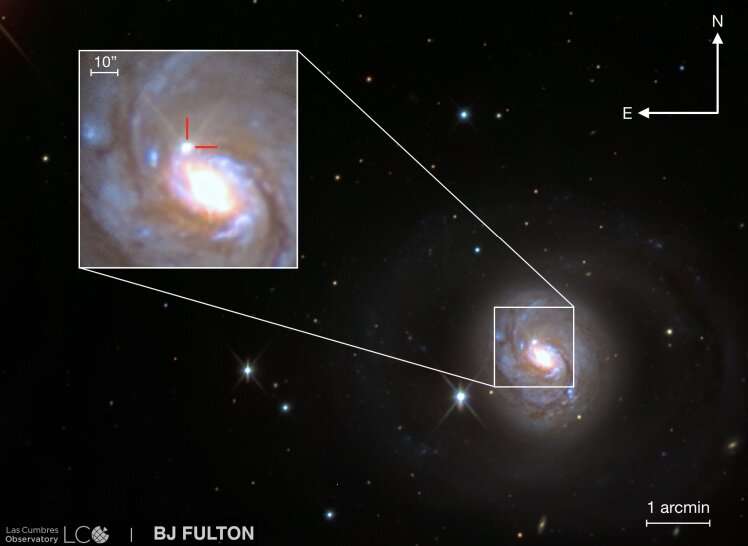A color image of SN 2018ivc and its host galaxy NGC 1068 composed of multiband observations obtained with Las Cumbres Observatory. The inset shows a close-up image of the nuclear region of NGC 1068. SN 2018ivc is indicated with the red guider lines northeast of the nucleus. Credit: Bostroem et al., 2019.
An international team of astronomers reports the discovery of an unusual Type II supernova in the galaxy NGC 1068, as part of the DLT40 survey. The newly detected event, designated SN 2018ivc, exhibits rapidly changing light curve, what is uncommon for stellar explosions of this type. The findings are detailed in a paper published September 16 on the arXiv preprint server.
Type II supernovae (SNe) are the results of rapid collapse and violent explosion of massive stars (with masses above 8.0 solar masses). They are distinguished from other SNe by the presence of hydrogen in their spectra. Based on the shape of their light curves, they are usually divided into Type IIL and Type IIP. Type IIL show a steady (linear) decline after the explosion, while Type IIP exhibit a period of slower decline (a plateau) that is followed by a normal decay.
In November 2018, a group of astronomers led by Azalee Bostroem of the University of California, Davis, detected a new supernova during the ongoing DLT40 survey—a search for SNe in nearby galaxies (less than 130 million light years away). Follow-up observations of this event suggest that it is an unusual supernova of Type IIL.
"We present the discovery and high-cadence follow-up observations of SN 2018ivc, an unusual Type II supernova that exploded in NGC 1068," the astronomers wrote in the paper.
SN 2018ivc was detected on November 24, 2018 in the Seyfert 2 galaxy NGC 1068 located some 33 million light years away from the Earth. Follow-up observations of this source revealed that the light curve of this supernova declines piecewise-linearly, changing slope frequently. In particular, the light curve was observed to change slope approximately every 10 days for the first 40 days of evolution before settling onto a linear decline.
Moreover, it was found that the rapidly evolving spectra of SN 2018ivc are dominated by hydrogen, helium, and calcium emission lines. The study also revealed that the ejecta from this explosion are interacting with the circumstellar medium.
Taking into account the results of the study, the astronomers concluded that SN 2018ivc is a Type IIL supernova. However, they noted that some properties make it an unusual event when compared to other SNe of this type.
"Although the declining light curve indicates that this is a Type IIL-like SN, there is evidence that the progenitor is more complicated than that of the typical Type IIL-like SN. The strong He i lines, not always visible in Type IIL-like SNe, could indicate that the progenitor lost most of its hydrogen envelope," the paper reads.
The researchers added that the progenitor of SN 2018ivc could have an initial mass of around 25 solar masses. They underlined that this calculation is uncertain and more studies regarding the role of mass loss in stellar evolution are required to better characterize the progenitors of such explosions.
More information: K. A. Bostroem, et al. Discovery and Rapid Follow-up Observations of the Unusual Type II SN 2018ivc in NGC 1068 arXiv:1909.07304v1 [astro-ph.HE]: arxiv.org/abs/1909.07304
© 2019 Science X Network
























